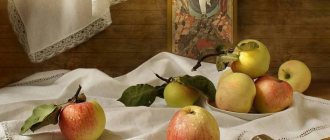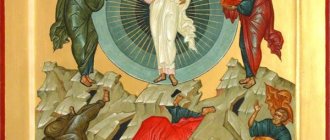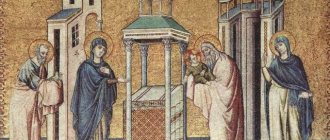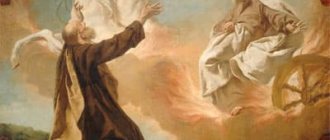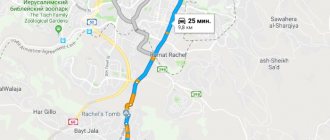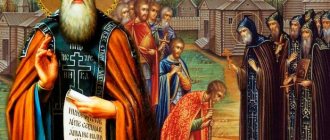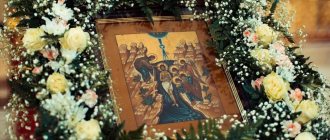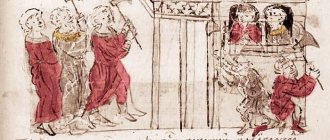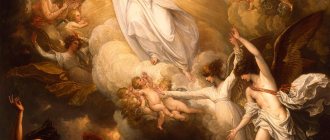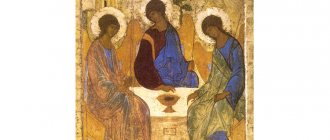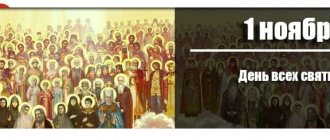On August 19, the Russian Orthodox Church celebrates a great holiday called the Transfiguration of the Lord. This holiday belongs to the twelfths and is considered one of the important holidays.
...He (the Lord) was transfigured before them (the disciples): and His face shone like the sun, and His clothes became white like light...
(Matt. 17:2)
Icon of the Transfiguration of the Lord. Photo: pravlife.org
The history of the holiday of the Transfiguration of the Lord is described in all the gospels
Jesus Christ told his disciples that death was prepared for Him, and three days after it He would rise again. The disciples could not believe such words, because they considered Him the Messiah, Who should liberate Israel.
A few days after this prophecy, Jesus went up to Mount Tabor to pray with John, Peter and James. These were his closest students. It is believed that it was here that the event that can be seen on the icon took place.
This is what is written about this event in the Gospel of Matthew: “He was transfigured before them: and His face shone like the sun, and His clothes became white as light (Matthew 17:2). But the miracle didn't end there. Elijah and Moses appeared next to Jesus Christ. These are the Old Testament prophets who spoke to Him.
In the picture we see that the prophets Elijah and Moses stand next to Christ. The frightened disciples of Christ are also depicted here. Photo: xn--b1alidk0a8d.xn--80asehdb
This event made a huge impression on the disciples of Jesus Christ. They were especially shocked when God’s voice came from the cloud:
…This is My beloved Son, in whom I am well pleased; Listen to him.
(Matt. 17:5)
When this cloud disappeared, Jesus remained with his disciples. He told His disciples not to tell anyone what they saw and heard.
Medieval Renaissance icon painter
The name of Theophanes the Greek is in the first rank of ancient Russian icon painters; his outstanding talent was already recognized by his contemporaries, calling him “a very cunning philosopher,” that is, very skillful. He made a huge impression not only with his works, but also as a bright personality.
Unfortunately, the dates of the artist’s life are unknown. Presumably they fall on 1340–1410. From the Byzantine Empire, Theophanes arrived in Rus' as an already established master. We learn about this from a letter from Epiphanius the Wise, an ancient Russian writer and disciple of St. Sergius of Radonezh, to Cyril, Archimandrite of the Tver Spaso-Afanasyevsky Monastery. Epiphanius reports that Theophanes painted forty churches in Constantinople, Galata (a suburb of Constantinople), Kafa (a city in the Crimea, modern Feodosia) and other cities. In Rus', as Epiphanius writes, the Greek worked in Veliky Novgorod, Nizhny Novgorod, Pereslavl-Zalessky, Kolomna and Moscow.
What is surprising is not only the manner of Theophanes the Greek (which will be discussed below), but also his very personality. Frescoes and icons give an idea of him as an outstanding artist and representative of hesychasm. But, as Epiphanius the Wise notes, the Byzantine master was an extraordinary personality, he painted freely, regardless of samples, preached from the scaffolding, and wittily answered questions from people who came in crowds to the cathedral, where he painted frescoes. Epiphanius describes the Greek as we would describe the masters of the Renaissance. But, apparently, this was Feofan, a Byzantine master who left his bright mark on ancient Russian art.
The icon “Transfiguration of the Lord” by Theophanes the Greek is especially revered
Transfiguration. What unusual things can you see every year on Mount Tabor?
Theophanes the Greek is a famous outstanding icon painter. B depicts Jesus. In ordinary times He is dressed in modest clothes, but here He is revealed in His greatness and power. Below on the icon we see the disciples of Christ who fell in fear.
Icon of the Transfiguration of the Lord by Theophanes the Greek. Photo: sevorop.ru
The icon is divided into 2 parts. In the upper part we see the celestial part, which is depicted in light colors. The bottom one is shown in dark colors. Such a contrast symbolizes the Divine pure sky and the sinful earthly creature.
Meaning
The icon is divided into two equal parts along an imaginary horizontal axis. The top half depicts a brand new world presented by the glorified Jesus Christ and the prophets Elijah and Moses. While the lower part depicts our temporary earthly reality, represented by Jesus' disciples - Peter, James and John.
In the center at the top stands Jesus Christ, blessing with both hands, dressed in white. His tunic is white (a soft blue tone) and his fur is tinged with red (a subtle reddish or rather pink tint). These colors can symbolize the divine nature as well as the human nature of Christ, because even in his glory he retained a human body.
On the right shoulder of the tunic there is a stripe: the clavus, a symbol of Jesus' royal dignity, which emphasizes the power of his blessing. The serious and noble face of Christ, framed by long, dark, straight, combed-back hair and a short beard, seems to be addressed to all humanity.
Christ is surrounded by a circular halo, the outer ring of which is painted dark brown, then, below, a light brown ring, and the inner part is formed by a deep red-orange circle with a jagged edge, extending from the figure. Christ.
Thin golden rays from the halo representing the Sun, the source of light, the symbol of Christ (Christ, the light of the world), radiate evenly and densely in all directions. Next to the round halo are the letters IC on the right and XC on the left, which are the initial and final letters of the name of Christ (IHCOC, XPECTOC) (Exodus 3:14).
The background of the icon is orange. Orange is made by mixing red and brown. The red color in the background of the icon means the triumph of eternal life, and brown is the color of the earth and everything temporary. Thus, the orange background color can symbolize the victory of the eternal over the temporary.
To the right of Christ we see the barefoot prophet Elijah, dressed in a dark blue-green tunic, with a dark purple hemat (cloak) decorated with gilding.
he is depicted as an elderly man with long, gray, slightly curly, combed-back hair and a long beard. His serious face with beautiful features is turned to the Lord. In his left hand he holds a scroll, and in his right he points to the Lord.
To the left of Christ is the Prophet Moses, facing the Lord.
he is depicted as a middle-aged man with a high forehead, short curly dark brown hair, and a short beard. He wears a long dark blue tunic with a bright red himat, decorated with gilding. He holds a book in his hands.
The gilding of the robes of both saints means that they are already glorified. All three characters stand on hills of different shades of brown.
A huge beam of golden rays shines from the figure of Christ, it is painted in a bright red color, branching into three rays, each of which points to one of the three apostles depicted at the bottom of the icon, on Earth, in a predominantly grassy area, dark green, sometimes interrupted by various brown shades. These are the real and symbolic colors of the earthly world. Green here means the Holy Spirit, who illuminates everything, everywhere.
On the right, the Apostle Peter kneels before the Lord. She extends her left hand to him, amazed at the unexpected revelation he is witnessing. He has short curly gray hair and a short curly beard. He wears a dark blue tunic and a walnut-brown himation.
Two of Jesus' other disciples had just woken up and fallen asleep from exhaustion. In the center is the Apostle John, kneeling with his arms outstretched and his head bowed, as a young man with a meek face, no beard and long curly dark brown hair. Her clothes are a dark green chiton and a dark red himation, decorated with gilding.
On the left lies the Apostle James, his face turned down and his gaze looking forward. He has short curly brown hair and a short beard, a red tunic decorated with gold, and a dark blue-green himation. The gilding of the apostles symbolizes that the reflection of the glory of Christ falls on them.
On the Feast of the Transfiguration of the Lord, the icon is brought to the center of the temple
On the Feast of the Transfiguration of the Lord, the icon is brought to the center of the temple. Prayer chants are performed in front of her.
On the day of the celebration and the day before, the icon of the Transfiguration of the Lord is brought to the center of the temple for the worship of believers. Photo: tihvinskiy.ru
How does the icon of the Transfiguration of the Lord (Christ) help? The icon helps to cleanse the soul of sins and strengthen one’s faith.
Two extremes of modern icon painting
Mikhail Pyzhov. "Transfiguration". Church of the Resurrection of the Lord in Sokolniki. Photo by P. Smertin
— How does a modern icon differ from an ancient one, if, of course, it is different?
“Even the decades in the 14th and 15th centuries are different. So, if we talk about a modern icon, then I can ask you in response: what is a modern icon? The icon of the 1980s has its own face, the icon of the 90s has its own. The surprise is not that one master is different from another, but that there is something in common between them. For example, the artists of the 90s have something in common that distinguishes them from the icon painters of the 2000s.
— How is our 21st century reflected in the icon? In general, how can you see a reflection of time in an icon?
“For now, this can only be felt, and only the next generation will be able to comprehend all the details. Such things are more visible from afar. Apparently, every time sets its own tasks, each time has its own temptations.
Willingly or unwittingly, consciously or unconsciously, the artist wants to answer some questions.
It seems to me personally that now, due to the spread of electronic media, the icon has become more authentic, more academic.
Today's icon painters cannot even imagine the ignorance in which artists lived even 20 years ago. Now all this has become more accessible, and this has both pros and cons.
An ancient icon painter could not, for example, take and enlarge a fragment of the work of his predecessor. But we can see all this, and this is such a high art that we want to submit to its influence and imitate it as accurately as possible.
Interior decoration of the Church of the Resurrection of Christ in Sokolniki. Photo from the site www.xbxc.ru
Now in icon painting there are two extremes: either strong imitation, or a strong individual principle.
— What exactly is the creativity of an icon painter if he paints within the framework of the canon? How does the icon reveal his personality, what makes his style recognizable?
- You know, there is such a Canon to the Comforter Spirit, which was written by Maxim the Greek in captivity. When I read it for the first time, I was very surprised that the Comforter Spirit was asked first of all for repentance. Not about spiritual gifts, including creativity, but specifically about repentance.
I think that church creativity should proceed from this. If repentance is understood as recognition of one’s shortcomings, miscalculations, failures, then this is not entirely accurate. Heartfelt contrition, that is, the union of mind and heart - this is important. If it somehow manifests itself in the icon, then it will become a sermon for more people.
People are more influenced by preaching that comes from a contrite heart. Color and pattern are not so important here.
—Can we say that the icon is somewhat similar to a prayer in which a person meets God?
— Here you need to clarify which prayer and which icon. You know, Alexey Fedorovich Losev in his book “Essays on Ancient Symbolism and Mythology” notes that in antiquity there was also prayer, asceticism, and monasticism. The only thing that was not there, from Losev’s point of view, was repentance and contrition. That is, if prayer comes with contrition of heart, then we can say that the ancient icon was similar to a prayer in which “the individual meets God.” And we are still good if we are at the very beginning of the journey.
On the evening before the holiday, a canon is read in front of the icon of the Transfiguration of the Lord
On the evening before the holiday, a canon is read in front of the icon of the Transfiguration of the Lord. On this day, the canon can be read at home.
The prayers of the canon must be read sincerely, from a pure heart.
Canon:
Song 1
Irmos: The faces of Israeltestia, having driven away the Black Ponte with damp feet and driven away the wet depths, the horsemen of the three-statted enemies, seeing immersed in it, girded with joy: let us sing to our God, for he has been glorified.
Glory to Thee, our God, glory to Thee.
The animal verbs are a friend of Christ, and about the Divine Kingdom, speaking: in Me know the Father; As if surrounded by an unapproachable light, we sing in joy: Let us sing to our God, for we have been glorified. (Twice.)
Glory: You will be clothed with power, O friends of your disciples, and you will be wonderful in their riches, for you will be filled with glory, for I will appear brighter than the sun, shining in the joy of those who sing: Let us sing to our God, for I have been glorified.
And now: Today Christ, on Mount Tavorstei, having shone clearly with the Divine dawn, as promised, the disciple revealed his face; Having filled the luminous Divine dawn, I girdle in joy: I will sing to our God, for I have been glorified.
Song 3
The bow of the mighty is weak, and the weak are girded with strength; for this cause may my heart be strengthened in the Lord.
Glory to Thee, our God, glory to Thee.
You have clothed yourself in all of Adam, O Christ, the darkened one, having changed, you have enlightened the ancient nature and by changing your sight you have made God. (Twice.)
Glory: By a pillar of fire, and by a cloud of old, Who was led in the desert of Israel, today on Mount Tabor, Christ indescribably prays in the light.
And now: By the pillar of fire and by the cloud of old, Who was led in the desert of Israel, today on Mount Tabor, Christ indescribably prays in the light.
Lord, have mercy (three times).
Sedalen, voice 4th
On Mount Tavorstei you were transfigured, O Jesus, in the midst of Elijah and Moses the Wise, with James, and Peter, and John. Peter, being with him, said this to You: there is good here to create three canopies, one for Moses, and one for Elijah, and one for You, the Master Christ. Even then, Thy Light shone forth, enlightening our souls.
Glory is the same now.
Song 4
I have heard Thy glorious sight, O Christ God, for Thou art born of the Virgin, and delivered from flattery those who call: Glory to Thy power, O Lord.
Glory to Thee, our God, glory to Thee.
Imagining the Law in Sinai in writing, O Christ God, in clouds, and fires, and darkness, and in a whirlwind, you appeared to us: glory to your power, O Lord.
Glory to Thee, our God, glory to Thee.
May you assure Thy glorious structure, O Christ God, for Thou didst indescribably shine forth on Tabor, for Thou didst indescribably shine when He was born before the age, and Who set His ascension on the cloud.
Glory: Agreeing, I stand servilely before You, Master Christ, to whom You spoke with a pair of fire and darkness and subtle coldness: Glory to Your power, Lord.
And now: I proclaim the glorious Cross for Thy sake, who came to Tabor, like Moses who foresaw in Thy fire and bush of old, and Elijah, Christ, who was taken on a chariot of fire.
Song 5
Cut off the original light from the light, as in the light of deeds they sing of Thee, Christ, the Creator; guide our path in Thy light.
Glory to Thee, our God, glory to Thee.
The mountains have bowed down before You; For there is light and before our feet celestial rays, Christ, the sun has come, the earthly image has been pleased to receive you.
Glory to Thee, our God, glory to Thee.
Behold the Savior, - the cry of Moses and Elijah as a disciple, announced on the Mount of Holy Tabors - is Christ, Who of old proclaimed the Existing God.
Glory: The unchangeable nature, mingled with the human, abundantly depicted the immaterial Divinity as the Light of the Apostle, ineffably arose.
And now: You, the ever-present radiance, in the glory of the Fatherland, the disciple who saw you rise, Christ, I cry out to You: guide our paths in Your light.
Song 6
When I was in sorrow, I cried out to the Lord, and the God of my salvation heard me.
Glory to Thee, our God, glory to Thee.
There is a radiance greater than the sun. The clearest light, the Savior, shining on Tabor, enlightened us. (Twice.)
Glory: Having ascended Mount Tabor, you were transformed, O Christ, and, having darkened all flattery, you enlightened us.
And now: The glorious apostles, having come to know You God, were amazed at Tabor, Christ, and bowed their knees.
Kontakion, tone 7
You were transfigured on the mountain, and as the host of Your disciples, they saw Your glory, O Christ God, so that when they see You crucified, they will understand the free suffering, and the world will preach that You are truly the Father’s radiance.
Ikos
Arise, laziness, who have always sunk to the ground, my soul's thoughts, rise up and rise to the height of the Divine ascent. Let us come to Peter and to the Zebedees, and together with them we will reach Mount Tabor, so that we may see with them the glory of our God, and hear the voice that we have heard from above, and preach the Father’s radiance.
Song 7
Abraham, sometimes in Babylon, the youths quenched the flames of the caves, crying out in songs: Our father, God, blessed art thou.
Glory to Thee, our God, glory to Thee.
Enveloped in the Light of unapproachable glory on Mount Tavor, the apostles cried out to Christ: our father, God, blessed art thou.
Glory to Thee, our God, glory to Thee.
We delight in the radiance of the Divine sound and the dew-bearing cloud, O Christ, and in Thy dawn, O apostles: our Father, God, blessed art thou.
Glory: In the unapproachable Light, like the sight of Thee, Peter, on Mount Tabor, Christ, cry out: our father, God, blessed art thou.
And now: With the Head of life, Christ being, children of Zebedee, as if you gave up the Light, you roared: our father, God, blessed art thou.
Song 8
In Babylon, the youths, inflamed by Divine jealousy, courageously asked down the rebuke of the tormentor and the flame, and, cast into the middle of the fire, watered the waist: bless, all the works of the Lord, the Lord.
Glory to Thee, our God, glory to Thee.
Carrying everything with a wave, Christ ascended Mount Tabor with his most pure feet, on which the rays of the sun shone on his face, like the elder who sang to the law and showed grace: bless, all the works of the Lord, the Lord.
Glory to Thee, our God, glory to Thee.
With unapproachable glory on the mountain appeared the indescribable Favors, the unpossessed and unstoppable Light, the Father's radiance, having made clear the creation, the people of God, singing: bless, all the works of the Lord, the Lord.
Glory to Thee, our God, glory to Thee.
Moses and Elijah standing in a sacred manner on Mount Tabor, having seen the Divine mark clearly in the Hypostasis, having seen Christ in glory in the Fatherland, they sang: bless, O all the works of the Lord, the Lord.
Glory: Who is sometimes glorified in the Divine eye for the appearance of the face of Moses, but Christ, as he is clothed with a robe, Light and glory, for He is self-made Light, illumines those who sing: Bless, all the works of the Lord, the Lord.
And now: From the luminous cloud of Christ, the disciples were embraced by sight on Tabor and fell on their faces to the earth, their minds enlightened, with His Father and the Spirit: bless, all the works of the Lord, the Lord.
Song 9
Chorus: Magnify, my soul, the transfigured Lord on Tabor.
Irmos: Thy Nativity appeared incorruptibly: God passed from Thy side, like the Flesh-Bearer appearing on earth and living with men. Thee, Mother of God, is why we magnify everything.
Horrify with the new light of day, the disciples suddenly illuminated, each other in vain, surprised and bowed to the ground, bowing to You, the Lord of all.
The noise from the cloud was sent by God, announcing a miracle: the Father of Lights, - This is My Beloved Son, - the apostle cried out: Hear him.
The new one has seen and is glorious, the voice of the Father has inspired, on Tabor the Word of the servant, the image of the Primordial One, This is, - crying out, - our Savior.
The indispensable image of Existence, the immovable, the immutable seal, the Son, the Word, the Wisdom and the Arm, the right hand of the Most High, the Power, we sing of You with the Father and the Spirit.
Svetilen
The unchanging Light, the Word, the Light of the Father, unborn, in Thy revealed light, today on Tabor the Light is seen by the Father, the Light and the Spirit, instructing all creation with the Light. (Thrice.)
By leaving a comment, you accept the user agreement
Superlight darkness
Theophanes the Greek is also credited with creating the Don Icon of the Mother of God (c. 1395). There is no reliable information in favor of Theophanes’ authorship, but the painting style reveals the hand of a Greek master, and the interpretation of the image correlates with hesychast teaching. The painting style is lush, free, the colors are saturated, creating a precious surface, the light pulsates inside the form like a clot of energy. The combination of blue and gold is luxuriously played out. The faces of Christ and the Virgin Mary are painted thinly, in many layers, the soft melt with a slight blush creates a feeling of warmth of the flesh, a gentle light flows from the eyes. The artist does without outwardly extravagant techniques, as was the case in Novgorod frescoes, but at the same time creates an image full of beauty and spiritual strength.
Don icon. Feofan the Greek
The Don Icon is double-sided, external, it was a temple image of the Assumption Cathedral in the city of Kolomna, on its reverse side it is written “The Dormition of the Blessed Virgin Mary.” And again we see a special interpretation of the image. The Mother of God lies on the bed, the apostles came to say goodbye to Her, behind the bed stands Christ, holding in his arms a small figurine in white shrouds - this is the soul of the Mother of God, born for eternal life. A burning candle is placed in front of the bed, this is a symbol of life, the candle, when burned, gives off light, a symbol of prayer offered to God, as well as a symbol of the Mother of God, who in the Akathist is called the “light-receiving candle.” But like a burning candle, the figure of Christ in golden robes with a bright red seraphim flaming above Him is also painted. The light lines up the vertical axis of the composition and, together with the horizontal bed of the Mother of God, forms a cross - a symbol of Christ’s victory, Resurrection, and the Triumph of life over death.
The mandorla is unusually interpreted on this icon - the radiance of glory around Christ; it is written in dark blue. This finds an explanation in the hesychast tradition. The hesychast fathers taught about the unknowability of God by the rational mind, and the Divine Light was called “incomprehensible darkness” or, in the words of St. Gregory Palamas, “super-light darkness.” Unapproachable light is often perceived by a person as blinding darkness. The meeting with him by many ascetics was perceived as entering darkness. Let us remember that Paul was blinded by this Light on his way to Damascus (Acts 22 :6-11). The image of the Dormition as birth into a new life is built on the opposition of light and darkness, life and death, the divine and the human.
Deesis. Feofan the Greek
Feofan the Greek worked a lot in Moscow, he painted the Kremlin cathedrals. According to the chronicle, in 1405, by order of Grand Duke Vasily Dmitrievich, the painting of the princely house church of the Annunciation was carried out by an artel, headed by three masters: Feofan the Greek, Prokhor from Gorodets and monk Andrei Rublev. The iconostasis in which Theophanes wrote the deesis (an icon or group of icons in the center of which Christ is depicted) has been preserved. The brightness and originality of the Greek’s manner manifested itself here with amazing force. The central image of the Savior in the Forces has been preserved least fully, but it is clear that it was written powerfully and masterfully. Christ in white robes, pierced with gold assist (touches of gold or silver leaf) sits on a throne. His face is noble and sublime, a majestic gesture of blessing makes one stop and become silent. John the Baptist and the Mother of God stand before Christ in prayer. The most expressive image of the Mother of God is in a deep blue robe with the lightest blue gaps, as if flickering in the darkness. This color resembles a precious stone - sapphire, symbolizing the mystery of the Ever-Virgin. The elongated figure looks like a candle, and the flame of this candle is the face of the Mother of God, the light flows in a soft and at the same time energetic stream from the eyes. The light seems to be restrained from within, but its power is such that it can ignite the whole world.
Theophanes the Greek left a bright mark on ancient Russian art. Traces of his influence are visible not only in icon painting and monumental art, but also in manuscripts, for example, the miniatures of the Khitrovo Gospel (late 14th century) and the Gospel of Fyodor Koshka (late 14th - early 15th centuries) have some similarities with the works of the Byzantine master. Art historians argue whether Feofan was Andrei Rublev’s teacher, but they worked together, and this could not but influence the formation of the younger master, who, after the departure of the great Greek, would determine the path of ancient Russian art, creating his own version of a transformed world.
Prayer before the icon
Lord Jesus Christ, we turn to you with sincere prayers. Save and keep our souls pure, deliver us from self-interest and envy, and do not allow us to step on a path that will lead us astray. We pray to You, show your grace to everyone who has chosen the path filled with righteous faith. Let me atone for all sins through pious deeds. Help, Lord, hide from our enemies who are thinking evil against our lives. Amen.
( 2 ratings, average: 5.00 out of 5)
Days of celebration
The date of celebration falls on August 19 (6). This day is one of the twelve church holidays and its significance in the Orthodox world is enormous. At this time, the Dormition Fast is underway, so every prayer and adherence to church canons will help you in spiritual growth and purification.
In the Russian tradition, the Transfiguration of the Lord is called the Second or Apple Savior. On this day, after consecration in the church, Orthodox Christians taste their harvest, treat those in need with gifts, and be sure to visit the graves of their ancestors to leave them apples.
